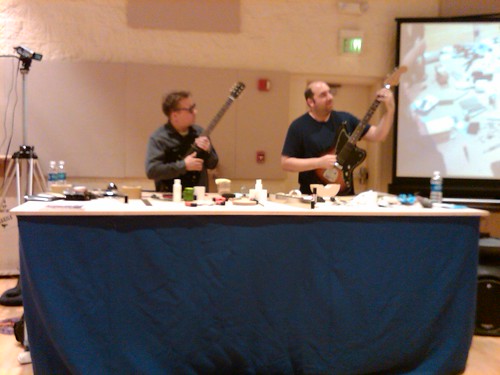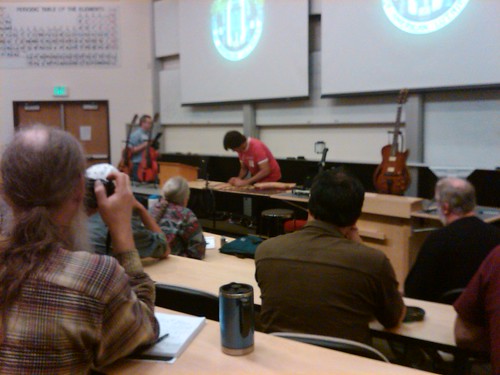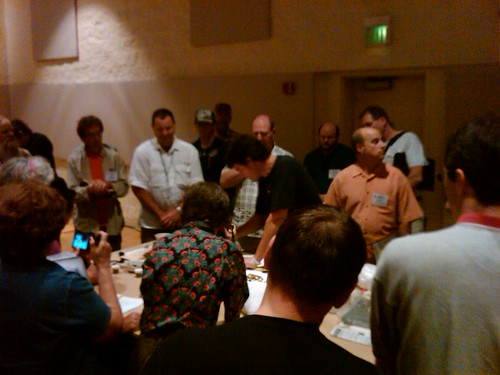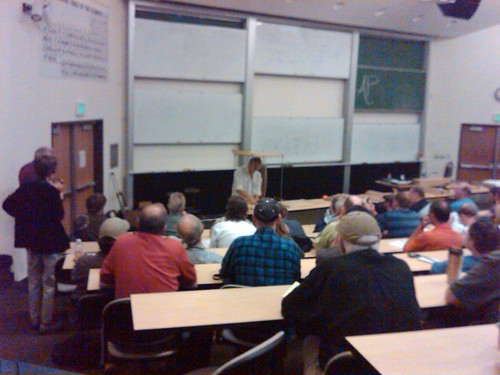I spent the past 5 days at the Guild of American Luthiers 2011 convention. It is only held every couple years, so I made sure to take some time off and attend. There's much more focus on acoustic guitars, mandolins, ukes and the like than electric instruments, but there's still a lot to be learned. Here are a couple lame shots from my cell phone camera and a few select notes from the classes I attended.
Refining factory setups on electric guitars: Going the extra mile.

This was taught by Erick Coleman from Stew Mac and Evan Gluck one of New York's top guitar techs. They both did setups on sight unseen guitars during the seminar. Cool seeing how they go about their setups.
- There is no one setup that works for everyone. Setups are like salt and pepper on a table so each one of us can season to taste.
Lutherie: Yesterday, Today, and Tomorrow
RE Brune is a well respected builder and fantastic Spanish guitarist. Very interesting seminar about the history of luthiere. Much time was spent on the potential impact of the Lacey act and CITES. This is going to be a royal pain...
- Luthiers are toolmakers for musicians and the tools must work well.
- As music changes, so too will the instruments.
- We cannot improve our art in isolation from musicians. (So true!!)
- Think of modern machinery (ie. CNC) as an apprentice doing traditional grunt work. Modern tools are not evil!
Rethinking the Semihollow Electric Guitar

This was taught by Stephen Marchione. He used to tech out of the Pensa-Suhr shop and now builds his own instruments. His guitars go for upwards of $20k!!!! I learned more about hide glue than I ever expected. He uses a CNC to complete much of the initial labor of his builds, but he can still spend 200-300 hours on a single guitar.
Beyond the Rule of 18: Intonation for the 21st Century
Taught by Don MacRostie (legendary tech/builder and works for StewMac) and Gary Magliari. Interesting discussion. Modern intonation is built around the 'Rule of 18.' As we know, intonation is a long standing issue with fretted instruments. Gary has worked out his own system of a compensated nut and frets that get intonation on each fret nearly perfect. Don talked about the practical applications and showed how he applied it to one of his own mandolins. This was a more animated discussion than I had expected. There are other folks out there that have worked up their own systems of compensation and some strongly held opinions!
Hand-Rubbed Sunburst Finishes

Taught by James Condino and was a live demonstration of him applying a sunburst finish on a mandolin. Very cool to see him mixing colors and applying them on the fly. A lot of playing with the color pallete.
- James lays out his hardware along with the unfinished instrument as he's applying this finish. That way, he can always compare the finish against the hardware colors to make sure they complement/blend well.
Production Techniques for the Custom Luthier

Taught by Charles Fox a well respected builder and teaches luthiere. Warmoth builds far more in a week than he does in a year, but it was interesting to see how he approaches production on a smaller scale. Charles brought in a handful of simple jigs to illustrate how much of the process could be streamlined and how accuracy and efficiency can be improved significantly.
Archtop Guitar with an Italian Flair
Stephen Marchione again. Interesting class on his approach to design and building. He talked more about design concepts and his goals to make something that was beautiful, long lasting and functional.
- What's the player's expectations? How often do we start projects without a clear goal? If so, how do we know if we miss it?
- Pay attention to the little things. It's called Craftsmanship!
Vintage Restoration: Playability vs. Collectibility
Taught by Joe Konkoly who is the head repair tech for Elderly Instruments. Interesting discussion about the merits or repairing vintage instruments.
- Are the changes reversible? Remember, you probably weren't the first owner of the instrument and you probably won't be the last.
- When considering repairs, look at originality, sale-ability and collectability. If you have an early '50s Tele, you might want to leave it alone. Want to spray paint your Squier? Go ahead!
All in all, it was a long couple of days. I think I got as much out of hanging with the other builders during lunch and between seminars as I did during the seminars. Very cool bunch of people and very willing to share their knowledge. There were some incredible builds during the exhibition times and some incredible players too. I'll be digesting what I learned and pondering my next steps for a long time to come.
Refining factory setups on electric guitars: Going the extra mile.

This was taught by Erick Coleman from Stew Mac and Evan Gluck one of New York's top guitar techs. They both did setups on sight unseen guitars during the seminar. Cool seeing how they go about their setups.
- There is no one setup that works for everyone. Setups are like salt and pepper on a table so each one of us can season to taste.
Lutherie: Yesterday, Today, and Tomorrow
RE Brune is a well respected builder and fantastic Spanish guitarist. Very interesting seminar about the history of luthiere. Much time was spent on the potential impact of the Lacey act and CITES. This is going to be a royal pain...
- Luthiers are toolmakers for musicians and the tools must work well.
- As music changes, so too will the instruments.
- We cannot improve our art in isolation from musicians. (So true!!)
- Think of modern machinery (ie. CNC) as an apprentice doing traditional grunt work. Modern tools are not evil!
Rethinking the Semihollow Electric Guitar

This was taught by Stephen Marchione. He used to tech out of the Pensa-Suhr shop and now builds his own instruments. His guitars go for upwards of $20k!!!! I learned more about hide glue than I ever expected. He uses a CNC to complete much of the initial labor of his builds, but he can still spend 200-300 hours on a single guitar.
Beyond the Rule of 18: Intonation for the 21st Century
Taught by Don MacRostie (legendary tech/builder and works for StewMac) and Gary Magliari. Interesting discussion. Modern intonation is built around the 'Rule of 18.' As we know, intonation is a long standing issue with fretted instruments. Gary has worked out his own system of a compensated nut and frets that get intonation on each fret nearly perfect. Don talked about the practical applications and showed how he applied it to one of his own mandolins. This was a more animated discussion than I had expected. There are other folks out there that have worked up their own systems of compensation and some strongly held opinions!
Hand-Rubbed Sunburst Finishes

Taught by James Condino and was a live demonstration of him applying a sunburst finish on a mandolin. Very cool to see him mixing colors and applying them on the fly. A lot of playing with the color pallete.
- James lays out his hardware along with the unfinished instrument as he's applying this finish. That way, he can always compare the finish against the hardware colors to make sure they complement/blend well.
Production Techniques for the Custom Luthier

Taught by Charles Fox a well respected builder and teaches luthiere. Warmoth builds far more in a week than he does in a year, but it was interesting to see how he approaches production on a smaller scale. Charles brought in a handful of simple jigs to illustrate how much of the process could be streamlined and how accuracy and efficiency can be improved significantly.
Archtop Guitar with an Italian Flair
Stephen Marchione again. Interesting class on his approach to design and building. He talked more about design concepts and his goals to make something that was beautiful, long lasting and functional.
- What's the player's expectations? How often do we start projects without a clear goal? If so, how do we know if we miss it?
- Pay attention to the little things. It's called Craftsmanship!
Vintage Restoration: Playability vs. Collectibility
Taught by Joe Konkoly who is the head repair tech for Elderly Instruments. Interesting discussion about the merits or repairing vintage instruments.
- Are the changes reversible? Remember, you probably weren't the first owner of the instrument and you probably won't be the last.
- When considering repairs, look at originality, sale-ability and collectability. If you have an early '50s Tele, you might want to leave it alone. Want to spray paint your Squier? Go ahead!
All in all, it was a long couple of days. I think I got as much out of hanging with the other builders during lunch and between seminars as I did during the seminars. Very cool bunch of people and very willing to share their knowledge. There were some incredible builds during the exhibition times and some incredible players too. I'll be digesting what I learned and pondering my next steps for a long time to come.

